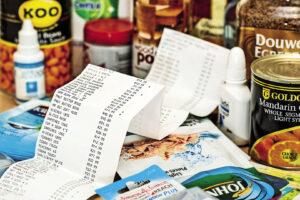Retail trade 2023: rationalising consumers, technological development
In this article we try to paint a picture of what happened in retail trade last year. 2023 was a challenging year for the food sector in Europe and overseas.
This article is available for reading in Trade magazin 2024/6-7
Consumers tightened their belts owing to the inflation, entailing a volume sales drop. The sector’s growth in Europe fell significantly short of the 12.8% annual food price inflation, with value sales expanding by just 8.6% last year.

Lagging behind annual food price inflation of 12.8%, the food sector expanded by just 8.6% in Europe in 2023
Rationalisation by switching to new retail channels and downtiering
While in 2022 both supermarkets and hypermarkets experienced a decline in sales, 2023 saw consumers switching to new retail channels due to their price-sensitivity and value-oriented shopping becoming a general trend, according to Euromonitor International. Supermarkets remained the most important channel, with sales up 0.6% in 2023. Consumers have reallocated their spending to food and household items. This poses a serious challenge to brands and certain retail formats, but the discount channel has benefited from it: discounters contributed 57% to absolute sales growth in global grocery retail in 2023. In Euromonitor International’s Voice of the Consumer 2023 survey nearly 45% of consumers said: they plan to save more and 35% will shop more at discounters. The personalisation efforts of food retailers continued last year. A survey by Dunnhumby has found that Amazon is ahead of all other retailers, performing best in the three factors most important for consumers: targeted savings, local product offers and a seamless shopping experience.
In-store experience is key
With the revitalisation of shopping in physical stores, retailers have made an attempt to transform these establishments into attractive places where customers can have fun, eat something and discover new products. Industry experts predict retailers will expand their fresh produce selections and introduce new in-store technologies this year. Grocers of all sizes have begun testing and introducing smart shopping carts across the US. Similar experiments have also begun in Europe, e.g. at Colruyt and Rewe. Private label products remained popular in 2023, and the downtiering trend has contributed to consumers specifically seeking out private labels. According to PLMA data, private label sales revenues grew by 4.7% year-on-year in 2023, outpacing the 3.4% sales growth of manufacturer brands. A consumer survey by McKinsey has found that 83% of respondents believe private labels are at least as good as manufacturer brands, with nearly 90% saying they offer similar or better value for money.

In Europe, 70% of those surveyed by Amcor regularly buy PL products. 50% of those who prefer these brands because of their quality will continue to stick to shoping PL in the future
Retail media is taking off, but there is still work to be done
Over the past few years many retailers have discovered the revenue potential of e-commerce platforms as advertising vehicles. Advertising revenues from retail media can alleviate the pressure on the financial results of companies generated by inflation and decreasing consumer spending. While digital retail media in Europe is still in its infancy – McKinsey estimates the market represented a value of EUR 11bn in 2023, growing at 15% annually – in the US the digital advertising industry is already a well-established sector. 2023 was a turbulent year for online food retailers. Although shoppers continued to show more interest in buying food online than before and at the start of the pandemic, last year industry growth fell short of the levels predicted a year earlier. According to McKinsey, the sector has also lost market share in Europe.
Building stronger foundations for selling online
There has been investment in online sales by retailers in 2023, but these efforts have been more about consolidating the foundations than improving the shopping experience. Focusing on promotions and programmes to retain and build loyalty among less well-off shoppers was key. According to a 2023 Dunnhumby study, 53% of leading retailers have seen a growing acceptance of loyalty programmes in recent years. 75% of the programmes retailer offer are exclusive members-only discounts – one of the most typical examples of this is Tesco’s “Clubcard Prices” initiative. While 2023 brought numerous mergers and acquisitions in the grocery sector, the extent of consolidation ultimately fell short of what many had predicted earlier, following Kroger’s announcement of acquiring Albertsons. In Europe Carrefour strengthened its positions in Northern France and Eastern Europe, with the acquisition of the Cora and Match chains.

Shoppers expect retailers to use AI in an effort to help them save money
Sustainability: the journey has just begun
None of the top ten European grocery retailers has reported progress on Scope 3 emissions, according to a McKinsey summary. This is partly because it is difficult to measure these emissions accurately. There was also much talk last year about regenerative agriculture. Most of the greenhouse gas emissions of food retailers come from agriculture – around 50% from the dairy and meat sectors alone. Regenerative practices are critical to meeting net-zero targets. Ten years from now we may look back on 2023 as a defining year in the history of retail trade: retailers took their first steps to adopt generative AI and other technologies on a large scale. Shoppers expect retailers to use AI to help them save money, Dunnhumby reported in November. //
Related news
More than 109,000 products bear the EU Ecolabel
🎧 Hallgasd a cikket: Lejátszás Szünet Folytatás Leállítás Nyelv: Auto…
Read more >The digital ecosystem is transforming: AI is coming alongside search, not replacing it
🎧 Hallgasd a cikket: Lejátszás Szünet Folytatás Leállítás Nyelv: Auto…
Read more >Crisis-Resistant Company in 2026: Why AI is the Best Insurance Against Political Cycles?
🎧 Hallgasd a cikket: Lejátszás Szünet Folytatás Leállítás Nyelv: Auto…
Read more >Related news
2026 begins in agriculture amid crises and a wave of investment – banking focuses on the dairy and pig markets, as well as CAP investments
🎧 Hallgasd a cikket: Lejátszás Szünet Folytatás Leállítás Nyelv: Auto…
Read more >Sovereignty Protection Office: According to the public, there is no place for foreign majority ownership in strategic sectors
🎧 Hallgasd a cikket: Lejátszás Szünet Folytatás Leállítás Nyelv: Auto…
Read more >Poor fruit harvest weighs on the pálinka sector
🎧 Hallgasd a cikket: Lejátszás Szünet Folytatás Leállítás Nyelv: Auto…
Read more >






